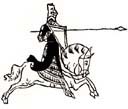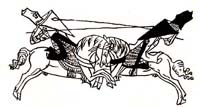 |
Polemics

 |
 |
From the Wrong End of the Binoculars |
  |
Atila Sinke Guimarães
Published in The Remnant, May 31, 2000
In its February 24 issue (page 6), The Wanderer published a critique of my book Quo Vadis, Petre? The author is Mr. Frank Morris from the editorial board of the paper. I acknowledge to him the right to express his thinking and disagree with mine. The critique of Mr. Morris left me indifferent, because I did not find in it the qualities that characterize an intellectual work of value. If it were up to me, I would not respond. I do so, however, at the request of some friends.
Three distinct parts can be considered in the critique in question: 1. Its ulterior motives; 2. Its impropriety in the use of ridicule; 3. Its six small arguments. I will analyze each part.
1. Ulterior motives.
The critique seems to have two ulterior motives: to present an excuse for John Paul II not to respond to the questions I asked him in Quo Vadis, Petre? and to present a defense of Vatican Council II in general.
As for excusing John Paul II, Mr. Morris affirms on my part: “The author claims to be only offering respectful inquiries to the Holy Father in this book. … The contents and the tone in this work suggest the author is presuming to teach Pope John Paul II, to suggest he is either unaware or complicit concerning what is really treason going on.”
This is the first time that I have heard the criticism of arrogance in the book’s tone. Up to now it has been criticized for the exact opposite – for having been too respectful. As for its contents, if a Catholic, in order to please persons like Mr. Morris, were not able to respectfully direct himself to the Pope requesting doctrinary explanations, we would have declared the reign of intellectual ineptitude in the Church, one that would only admit blind obedience to a Pope who would refuse to answer serious questions addressed to him. The haste of Mr. Morris to try to put me into the ridiculous position of teaching the Pope seems to reveal his desire to excuse John Paul II from responding to my filial request for explanations.
Further on, he continues with more emphasis in his attempt to justify John Paul II’s avoidance of a response: “It seems very unlikely the author would be ready to accept any reply from the Holy Father that was not in fact a full admission to and acceptance of the conclusions of the situation as presented in the book.” I can guarantee Mr. Morris that he is wrong. I would very affably accept the response of the Holy Father, and, should I still have some doubt on a matter, I would return to question him respectfully for the solution.
As for the defense of Vatican Council II, Mr. Morris has a defined position: “What the Council (Vatican II) did say of other religions is that some possess certain elements of salvation, which it explains belong properly to the Catholic Church which alone enjoys such elements fully and completely. One could hardly deny this without denying the validity of Baptism other than done within the True Church.” There is no need to discuss here the subtleties about the validity of Baptism. The question is another: Mr. Morris presents a defense of Vatican II, and my book opposed the thesis on religious pluralism that the Council defends by comparing it with the teaching of various prior Pontiffs.
Among such teachings, I repeat here an excerpt from Pius IX’s Encyclical Qui pluribus:
“Also perverse is the shocking theory that it makes no difference to which religion one belongs [religious indifferentism], a theory that is greatly at variance even with reason. By means of this theory, those crafty men remove all distinction between virtue and vice, truth and error, honorable and vile action. They pretend that men can gain eternal salvation by the practice of any religion, as if there could ever be any sharing between justice and iniquity, any collaboration between light and darkness, or any agreement between Christ and Belial” (Quo vadis, Petre? pp. 41-2).
It would be interesting to know how Mr. Morris explains the contradiction between his affirmation in defense of Vatican II and the teaching of Pius IX, and why he is trying to excuse John Paul II from making a response to an analogous question.
As a practical consequence of this part, one can conclude that Mr. Morris has assumed the roles of helping John Paul II to avoid responding to a legitimate inquiry and of defending Vatican II in one of its most censurable points, the admission of salvation in all religions. In passing, one could note in this critique how progressivism is supported by the “conservativism” of The Wanderer line.
2. Impropriety in the use of ridicule.
In a public intellectual dispute of good level, it is normal to avoid the use of sarcasm. This is all the more comprehensible when the persons involved are worthy of respect, be it by the intrinsic value of the intellectual work or by the acknowledgement of the effort of one who defends a thesis or publishes a book. Another factor that invites the avoidance of the use of sarcasm is humility: the one who objects could be wrong in his critique.
One can understand the use of irony when there is a great intellectual disproportion between the two parties who are disputing or after the demonstration of a flagrant error of the adversary.
Mr. Morris seems to ignore these rules of good sense. At the very beginning of his article, without any proof of some error on my part and without any evidence to sustain the intellectual heights from which he seems to situate himself, he launches against me two rounds of ridicule. He begins his article with these words: “This book has something of a Y2K-alarm quality, in this case concerning the Catholic Church. Accept it 100%, and you will fear doctrines crashing to the ground, heretics and unbelievers taking over and leading Catholics into false worship, and a general collapse of orthodoxy and a rout of Catholics loyalists.”
In the next paragraph, still laughing at his first joke, he adds another: “A surface reading of Quo vadis, Petre? would send some into the catacombs instantly, pulling a rock over the entrances behind them.”
I refrain from analyzing the comic qualities of Mr. Morris. I only register his infraction against the rules of good intellectual conduct. In this particular analogy, nonetheless, I find an element of content. He places me in the company of all those who expected a catastrophe at the passing of the millennium, a catastrophe that would begin God’s chastisement upon the world, foreseen at Fatima. This is precisely what I most respect and admire in those who prepared for Y2K. They are persons who have understood the gravity of the universal crisis in which we are living, a crisis that goes against all the values of Christian Civilization, but above all a crisis that affects the Holy Catholic Church. They see that such a situation cannot continue and demands a divine intervention. These Catholics who were wrong about a date were not, however, wrong in their analysis of the whole. Certainly such persons are among the most serious Catholics that there are today and among those who most love the Holy Church. It is, therefore, understandable that I feel a satisfaction to be placed in their company, and it is likewise comprehensible that the ridicule of Mr. Morris would leave me indifferent.
3. Six small arguments.
Mr. Morris presents six small arguments against Quo vadis, Petre?:
A. The interpretation made of the titles of martyr and saint used by John Paul II was improper;
B. The interpretation of John Paul II’s use of the title Doctor, applied to Luther, was inappropriate;
C. It was wrong to consider that the character and the passion of Luther could be judged by Catholic doctrine;
D. The application of a text of Pius IX prohibiting religious liberty was not right;
E. The presence and collaboration of heretics and schismatics at ecumenical councils would be justifiable, contrary to what is affirmed in the book;
F. The episode of “Quo vadis, Domine?” between Our Lord and St. Peter would not be historically verified.
Based on these six arguments, Mr. Morris concludes that I have exaggerated, that a great part of the book is made up of subjective interpretations and that, for this reason, it should be considered as a speculation without any base in reality. I will respond to each argument.
A. Title of martyr and saint.
In Quo Vadis, Petre? the concepts of martyr and saint are used in exactly the same sense as the current Catholic usage. Mr. Morris states that I am wrong, because according to him, “obviously the Pontiff is not using the words ‘martyrs’ and ‘saints’ in any defined way, that is, those who are proved to have died specifically defending their faith in Christ…”
It is interesting to note that the “proof” that I am wrong is only the insistence of Mr. Morris that it is obviously the contrary. He dispenses with bringing forth any rationale, fact or document. His accusation does not employ deductive logic (some type of reasoning), inductive logic (some fact), or the weight of authority (some document). He offers only his word: it is obvious – so that which is obvious to him is thus proved to all in a public dispute.
However, contrary to what Mr. Morris desires, John Paul II clearly defined martyr and saint in the sense the Church has always used them. And, more disagreeably for Mr. Morris, the definition of martyr is in the first excerpt that my book cites on the subject. In fact, these are the words of the Pope in the Encyclical Ut unum sint: “All Christian Communities …. have martyrs for the Christian faith. Despite the tragedy of our divisions, these brothers and sisters have preserved an attachment to Christ and to the Father so radical and absolute as to lead even to the shedding of blood” (QVP, p.10). That is, what John Paul II is wrongly applying to the other religions is precisely the same concept of martyr that exists in the Catholic Church: one who dies shedding his blood for love of the faith.
As for the definition of saint, John Paul II affirms in the same Encyclical that saints are “those who, at the end of a life faithful to the grace, are in communion with Christ in glory. These saints come from all the Churches and Ecclesial Communities that gave them entrance into the communion of salvation” (QVP, p. 14). That is to say, his definition of saint is essentially the same that the Church accepts, with an unjustified application to other religions.
It is lamentable that Mr. Morris did not read such documents with more attention before launching the accusation of exaggeration.
B. The title of Doctor conferred to Luther.
In Quo Vadis, Petre? there is the well-known statement of Cardinal Jan Willebrands considering Luther a “common master” or “common doctor” of Catholic and Protestant theologies. In order to justify his affirmation, Willebrands presents as proof the fact that Vatican Council II had placed various theses of Luther in its documents. The words “common master” employed by the Cardinal have become famous, marked the epoch and been praised by the progressivist current for some time. Immediately afterward in the book, I transcribe other praises of Willebrands of the heresiarch, in which he makes an account of the Protestant principles that were accepted by the Conciliar Church. Willebrands made these statements in the name of John Paul II. I also provide excerpts from the Pope’s letter to the Cardinal, commanding him to assist at the festivities to commemorate Luther. In this letter, John Paul II refers to the heresiarch as “Doctor Martin Luther.” I look at the three documents and say that applying the title of doctor to Luther “brings to mind” the title of “common doctor” or “common master” used by Willebrands years before.
Mr. Morris makes a casus belli of this statement. He turns to attack with his heaviest arm: his notion of the obvious. In fact, he writes, “It is obvious, however, the Pope speaks of ‘Doctor Luther’ in respect to the degree that was rightfully his.”
Once again, Mr. Morris does not bother to present any proof other than his curious notion of the obvious.
In responding, I affirm, first, that what Mr. Morris desires is not obvious because, immediately afterward, John Paul II praised the theological work of Luther in a manner similar to the eulogy of Willebrands. The Pope stated: “On this occasion, numerous Christians remember that theologian who … contributed substantially to the radical change of ecclesiastical and secular reality” (QVP, p. 21).
That is to say, his eulogy refers to theological matters and is not a mere academic formality as Mr. Morris stated. Second, I do not affirm that John Paul II indisputably used the title to refer to the eulogy of Willebrands; I say only that one praise “brings to mind” the other. Mr. Morris once again did not pay attention to what was written.
C. The religiosity and passion of Luther.
The book cites a passage of John Paul II about Luther in which there are several eulogies. I then made various commentaries on this. Mr. Morris separates from the whole of my argument one phrase to attack. He writes: “Guimarães finds the Holy Father’s use of the phrases ‘profound religiosity’ and ‘moved by an ardent passion…’ as not only ‘surprising’ but in contradiction to ‘the perennial teaching of the Church.’ Of course, it is not so. … Since the character and conscience of Luther cannot amount to doctrine.”
I respond. First, the religiosity and passion of any person can be judged by Catholic Morals. Mr. Morris seems to ignore that Morals is a part of Catholic doctrine.
Second, to eulogize the hatred that Luther had for the Papacy and the Catholic Church, qualifying them as “profound religiosity” and an “ardent passion for the question of eternal salvation” is a historical lie and, as such, contrary to the perennial moral teaching of the Church.
Third, Mr. Morris left out the principal point of John Paul II’s statement in which he refers to the “multifarious heritage” of Luther that would need to be re-examined. With this general intention, the Pope affirmed that there are many “points of convergence” between Catholics and Protestants. According to the whole of the statement, he insinuates that a positive reinterpretation of Luther and his errors is being sought. Therefore, the fact that Mr. Morris takes out only one phrase in order to make his attack seems to reveal his preconceived position in relation to the work that he is analyzing.
D. Religious liberty and the excerpt of Pius IX.
Mr. Morris makes a confused interpretation of the Syllabus of Pius IX. His intent is to prove that the Syllabus is not in contradiction to Vatican II, especially the Declaration Dignitatis humanae. If he had managed to do this, then the book would have one more error, because I generically criticize religious liberty, which was condemned by the prior Magisterium. I am not mentioning here the part of the book that displeased Mr. Morris because he failed to indicate the place. My critic is not clear in what he is criticizing.
The argumentation of Mr. Morris on this topic also is not clear. He tries to be subtle, but he stumbles in the application of the concepts that he used. It seems that he is unsuccessfully trying to develop an outline that someone more learned and nuanced offered him in order to criticize Quo vadis, Petre?
It does not seem necessary to enter here into a discussion about the concepts of moral liberty and physical liberty that Mr. Morris employs to “prove” that there is not a contradiction between the Syllabus and the documents of Vatican II. Suffice it to say that Cardinal Joseph Ratzinger confirmed this contradiction when he defined the principles of adaptation to the world of Gaudiun et spes and of religious liberty in other conciliar documents as forming a type of counter-Syllabus.
These are the words of Ratzinger: “If one is looking for a global diagnosis of the text [of Gaudium et spes], one could say that it, along with the texts on religious liberty …. is a revision of the Syllabus of Pius IX, a type of counter-Syllabus” (Les principes de la Théologie Catholique – Esquisses et materiaux, Paris: Tequi, 1985, pp 426f). Since it seems that one of the intentions of Mr. Morris is to please the Holy See, one would say it would be more prudent for him not to go further in his “demonstrations.” However, in case he really wants to be serious in proving that there is no contradiction between the Syllabus and the conciliar documents, he, together with his possible mentor, can read the book cited above and prepare another book review, this time against the Prefect of the Congregation for the Doctrine of the Faith.
E. Heretics and schismatics at Ecumenical Councils.
Quo Vadis, Petre? criticizes the pan-religious meetings and warns about the possibility of a new council in which heretics and schismatics would be present, deciding questions together with Catholics. Trying to justify a future pan-religious council, Mr. Morris cites an historian affirming that Protestants were invited to the Council of Trent to give suggestions.
I respond. First, I was unaware of the related fact. If it is true, it would indicate that the Fathers of Trent would have probably used the statements of Protestants as a work instrument in order to better refute them, because in all the doctrine of the Tridentine Council there is found the most pure and edifying anti-Protestantism. There is not the least vestige of the infiltration of heretical ideas.
Second, on the occasion of the convocation of Vatican Council I, Pius IX invited Protestants and other non-Catholics. He invited them not to collaborate with them at the Council, but in order to convert them, as is clearly demonstrated in the Apostolic Letter Iam vos omnes (Denzinger-Schönmetzer, 2997-2999). The two aforementioned facts do not support what Mr. Morris suggests, namely, that one should accept as normal the convocation of a pan-religious council in the near future.
F. Historicity of the episode Quo vadis, Domine?
Mr. Morris affirms: “The so-called meeting of Peter and Christ at Rome, with the question “Quo vadis?” being asked by Christ of Peter, is totally unverified historically. It remains on the level of legend.”
As in his whole book review, here also Mr. Morris is unfortunate in his attack. First, because the question was not made by Our Lord to Peter, but by Peter to Our Lord. This error would be pardonable but for the fact that at the beginning of the book he criticizes (p. 1) the episode is explained. Second, the episode is based on a good and respected tradition. As Mr. Morris should know, tradition also can be the source of historical verification.
For example, it was mainly by way of oral tradition that the whole Church was instructed on the Immaculate Conception of Our Lady, today a dogma of Faith. In an analogous manner, there is a solid and venerable tradition attesting to the veracity of the episode Quo vadis, Domine? As proof, there is a church, which was constructed on the site to commemorate the event. Therefore, the incident is not “totally unverified historically,” as Mr. Morris asserts.
G. Conclusion about the arguments.
The six small arguments of Mr. Morris amount to nothing. Each one of the arguments is unfounded. Therefore, his accusation that the work is exaggerated and unsupported by reality suffers itself from a “lack of historical verification.” However, what is proven is that in his book review he appears intellectually incompetent and morally unfair.
4. Conclusion about the book review.
There are various “conservatives” like Mr. Morris who take certain psychological presuppositions as reality. For them, the Pope always has to be right, the Council always has to be right. If they were living in the times of Popes Liberius, Vigilius and Honorius, who fell into heresies, they would praise those Pontiffs. I do not believe that they agree with all the errors, which were and are being committed, but they are afraid to face the reality head-on.
Confronted with the present-day ecclesiastical crisis, they nervously deny the evidence. They try to move the reality that aggresses them further away from themselves by means of “interpretations,” sophisms and subterfuges. They would be like someone who, in place of using the binoculars to bring the far-off reality nearer, would turn them around and use the wrong end of binoculars in order to push away the reality that is in front of his eyes. Some of these psychological presuppositions are present in the book review of Mr. Morris.
I relate the fact and I lament it. For what is happening is that such “conservatives” are becoming useful-innocents of progressivism. And, sadly, more and more useful and less and less innocent.
I leave here my suggestion to those in this group who are still well intentioned: Stop looking out of the wrong end of the binoculars.


Articles in the Polemic
 “A Lack of Historical Verification” “A Lack of Historical Verification”
by Mr. Frank Morris
 “From the Wrong End of the Binoculars” “From the Wrong End of the Binoculars”
by Mr. Atila S. Guimarães


|
Polemics | Home | News | Books | CDs | Search | Contact Us

© 2002-
Tradition in Action, Inc. All Rights Reserved
|
 |
|
